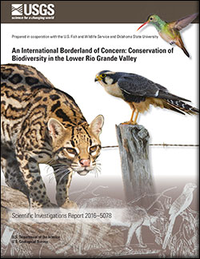An international borderland of concern: Conservation of biodiversity in the Lower Rio Grande Valley
Links
- Document: Report (9.31 MB pdf)
- Download citation as: RIS | Dublin Core
Abstract
The Lower Rio Grande Valley (LRGV) of southern Texas is located on the United States-Mexico borderland and represents a 240-kilometer (150-mile) linear stretch that ends at the Gulf of Mexico. The LRGV represents a unique transition between temperate and tropical conditions and, as such, sustains an exceptionally high diversity of plants and animals—some of them found in few, or no other, places in the United States. Examples include Leopardus pardalis albescens (northern ocelot) and Falco femoralis septentrionalis (northern aplomado falcon)—both endangered in the United States and emblematic of the LRGV. The U.S. Fish and Wildlife Service (USFWS) manages three national wildlife refuges (Santa Ana, Lower Rio Grande Valley, and Laguna Atascosa) that together make up the South Texas Refuge Complex, which actively conserves biodiversity in about 76,006 hectares (187,815.5 acres) of native riparian and upland habitats in the LRGV. These diminished habitats harbor many rare, threatened, and endangered species. This report updates the widely used 1988 USFWS biological report titled “Tamaulipan Brushland of the Lower Rio Grande Valley of South Texas: Description, Human Impacts, and Management Options” by synthesizing nearly 400 peer-reviewed scientific publications that have resulted from biological and sociological research conducted specifically in the four Texas counties of the LRGV in the past nearly 30 years. This report has three goals: (1) synthesize scientific insights gained since 1988 related to the biology and management of the LRGV and its unique biota, focusing on flora and fauna of greatest conservation concern; (2) update ongoing challenges facing Federal and State agencies and organizations that focus on conservation or key natural resources in the LRGV; and (3) redefine conservation opportunities and land-acquisition strategies that are feasible and appropriate today, given the many new and expanding constraints that challenge conservation activities in the LRGV. The LRGV faces every contemporary conservation challenge of the 21st century, but ongoing human population growth and its associated demands, international border issues, and oil, gas, and alternative energy development dominate impacts that affect conservation in the LRGV. Continued careful syntheses of existing and future information collected in the LRGV are needed on many biological and sociological topics to guide conservation activities. Quick response will no doubt be necessary to face contemporary and difficult-to-predict challenges such as climate change, diminished water availability and quality, spread of invasive species, and habitat loss and fragmentation. Complexities of a guarded international borderland add pressure to small patches of native habitat that remain in many places of the LRGV, particularly along the Rio Grande. Large connected corridors of restored native habitat could be the best option to maintain, and even enhance, the exceptional biodiversity of the LRGV in the face of exceptional human demand.
Suggested Citation
Leslie, D.M., Jr., 2016, An international borderland of concern—Conservation of biodiversity in the Lower Rio Grande Valley: U.S. Geological Survey Scientific Investigations Report 2016–5078, 120 p., https://dx.doi.org/10.3133/sir20165078.
ISSN: 2328-0328 (online)
ISSN: 2328-031X (print)
Study Area
Table of Contents
- Abstract
- Introduction
- Unique Aspects of the Lower Rio Grande Valley
- Ongoing Challenges Facing the LRGV
- Conservation Opportunities for the LRGV in the 21st Century
- Future Management Directions and Needs
- Conclusion
- References
- Appendixes A–C
| Publication type | Report |
|---|---|
| Publication Subtype | USGS Numbered Series |
| Title | An international borderland of concern: Conservation of biodiversity in the Lower Rio Grande Valley |
| Series title | Scientific Investigations Report |
| Series number | 2016-5078 |
| DOI | 10.3133/sir20165078 |
| Publication Date | July 20, 2016 |
| Year Published | 2016 |
| Language | English |
| Publisher | U.S. Geological Survey |
| Publisher location | Reston, VA |
| Contributing office(s) | Coop Res Unit Atlanta |
| Description | xii, 120 p. |
| Country | United States |
| State | Texas |
| County | Cameron County, Hidalgo County, Starr County, Willacy County |
| Other Geospatial | Rio Grande Valley |
| Online Only (Y/N) | N |
| Additional Online Files (Y/N) | N |


